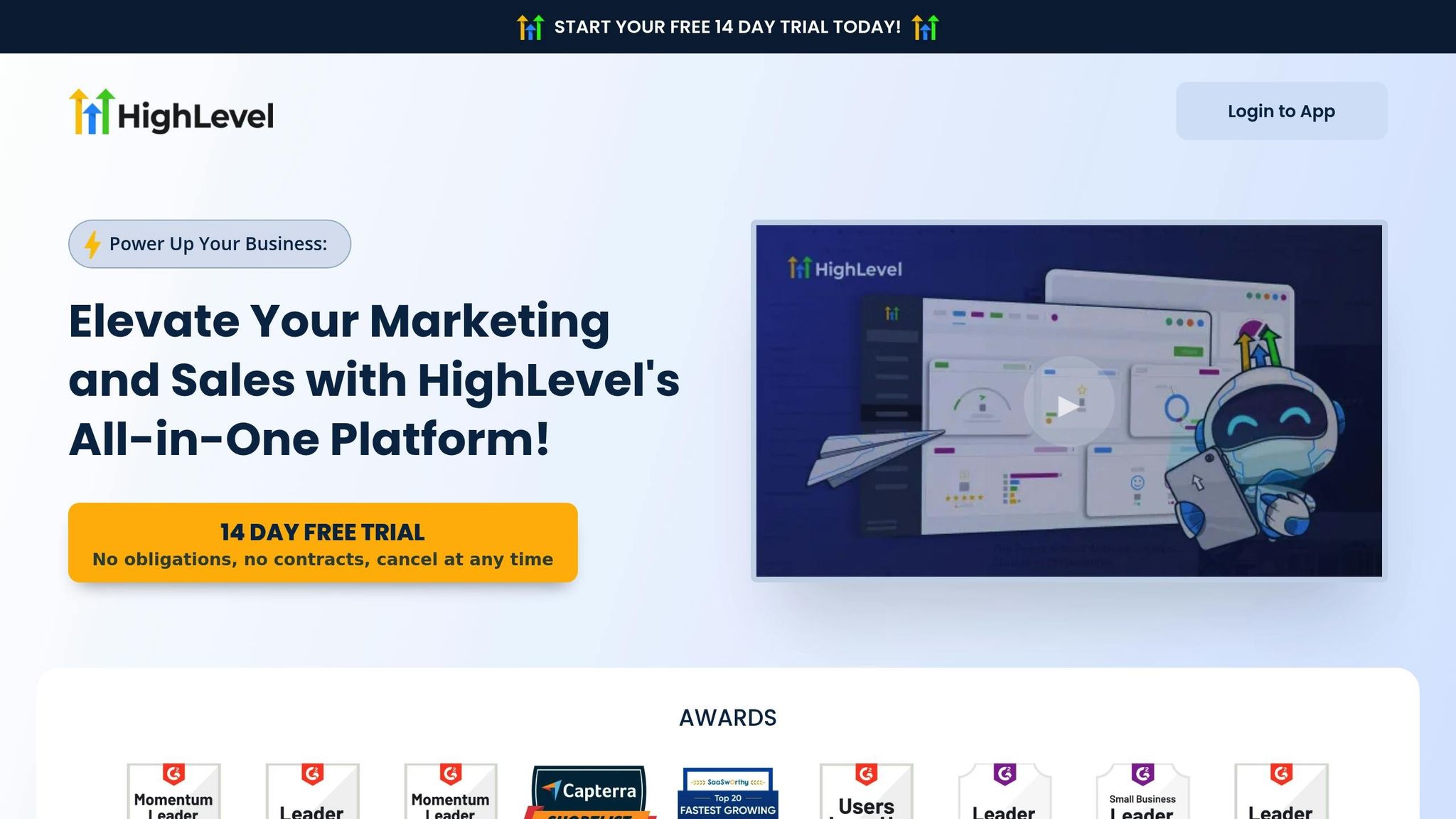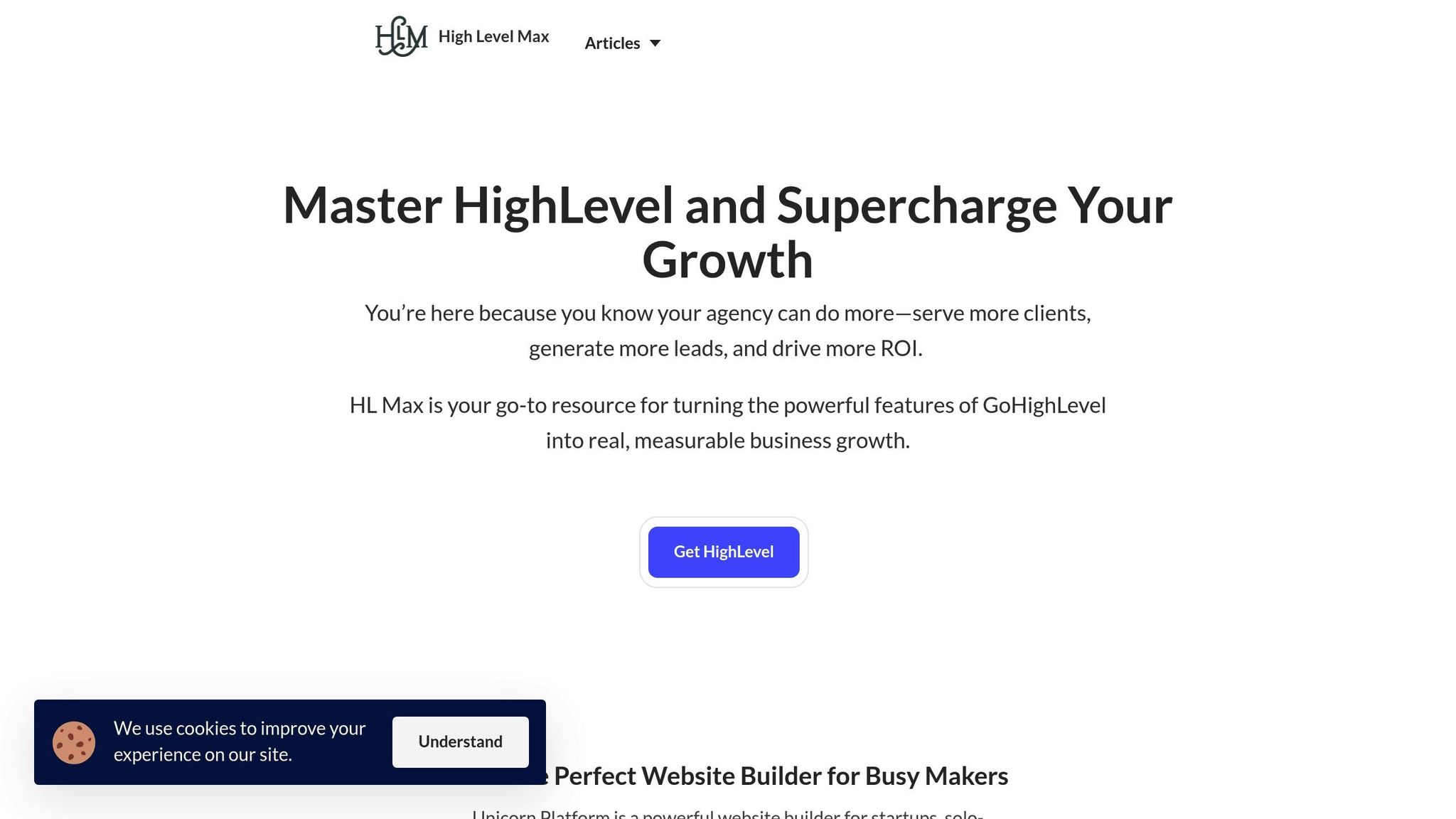Want to streamline your team's workflows and boost productivity? HighLevel's automation tools can help. They turn repetitive, manual tasks into automated processes, saving time and reducing errors. Here's what you need to know:
- Common Challenges: Teams often face delays, missed deadlines, and inconsistent processes.
- Key Features: Tools like calendar scheduling, sales pipeline management, and form optimization simplify team workflows.
- Automation Tools: Use triggers, conditions, and actions to automate tasks like lead assignment, follow-ups, and notifications.
- Visual Workflow Editor: A drag-and-drop interface makes automation setup easy, even for non-technical users.
- Integrations: Sync with calendars, communication apps, and analytics tools for seamless connectivity.
Pro Tip: Start with repetitive, time-consuming tasks and monitor metrics like time saved, error rates, and team adoption to measure success. HighLevel helps teams collaborate better, meet deadlines, and deliver consistent results. Ready to automate? Let’s dive in!
Ultimate GoHighLevel Workflow Tutorial For Beginners

Main Workflow Automation Tools
HighLevel offers tools to streamline everyday tasks, cutting down on repetitive work and allowing teams to focus on strategic priorities.
Workflow Rules and Logic
HighLevel's automation engine uses triggers, conditions, and actions to build detailed processes. Teams can design workflows tailored to specific events:
| Trigger Type | Condition Examples | Automated Actions |
|---|---|---|
| Form Submissions | Lead Score > 50 | Assign to Sales Rep |
| Campaign Response | Email Opened | Schedule Follow-up |
| Deal Stage Change | Value > $5,000 | Alert Manager |
| Task Completion | Priority = High | Update Pipeline |
Workflows can handle complex scenarios and parallel tasks to engage the right team members. For instance, when a high-value lead submits a form, the system can automatically:
- Assign the lead to a senior sales rep
- Add a task to the pipeline
- Notify the team
- Schedule an initial consultation
By connecting these workflows to external apps, teams can further streamline processes and save time.
Connected Tools and Apps
HighLevel integrates with the platforms your team relies on, ensuring smooth data flow and reducing manual work. These integrations help maintain consistency across your tools.
Some supported integrations include:
- Calendar Tools: Sync appointments across team schedules
- Document Management: Automate contracts and signatures
- Communication Apps: Link messaging and email platforms
- Analytics Software: Automatically track key metrics
This connectivity works seamlessly with the Visual Workflow Editor, making setup easier.
Visual Workflow Editor
The drag-and-drop editor simplifies automation for everyone on the team. Its visual layout clearly shows how each step connects, making workflows easy to understand.
Features include:
- Pre-built Templates: Quickly start with ready-made workflows
- Custom Blocks: Add unique steps to fit your needs
- Testing Tools: Check workflows before going live
- Version Control: Keep track of changes and updates
The editor’s user-friendly design allows teams to implement and adjust workflows quickly. It also encourages collaboration, ensuring workflows meet the goals of different departments.
Creating Team Workflows
Efficient workflows require careful planning. The goal is to improve team efficiency and deliver better results for clients.
Setting Workflow Goals
Use tools like HighLevel to set clear automation goals that address your team's specific needs. Focus on tasks that are:
- Repetitive: Frequently performed actions
- Time-consuming: Tasks that take up significant manual effort
- Prone to errors: Processes with a high likelihood of mistakes
- Client-focused: Activities that directly impact service delivery
To prioritize effectively, consider using a workflow priority matrix like this:
| Priority Level | Task Type | Time Impact | Error Risk |
|---|---|---|---|
| High | Lead Assignment | 4+ hours/day | High |
| Medium | Progress Updates | 2-3 hours/day | Medium |
| Low | Status Reports | 1 hour/day | Low |
Building Automation Steps
Here’s how to design workflows that work:
- Map the manual process: Understand each step of the current workflow.
- Identify triggers: Determine what will start the automated process.
- Define actions: Specify what happens at each stage.
- Set conditions: Include timeouts and other rules to handle different scenarios.
- Integrate tools: Connect the automation to relevant systems or platforms.
Tips for Configuration:
- Use clear, descriptive names for each workflow.
- Write detailed descriptions for better understanding.
- Set up error notifications to catch issues in critical paths.
Once the workflow is live, monitor its performance and refine it as needed.
Measuring Workflow Success
Use the following metrics to evaluate how well your workflow is performing:
| Metric | Target | Measurement Method |
|---|---|---|
| Time Saved | 75% reduction | Compare time before and after |
| Error Rate | Less than 1% | Track failed automations |
| Team Adoption | Over 90% | Monitor active usage |
| Client Satisfaction | Over 95% | Analyze survey response scores |
Steps for Ongoing Review:
- Check workflow logs daily during the first week.
- Conduct bi-weekly performance reviews.
- Collect team feedback monthly.
- Adjust triggers, actions, and conditions based on data insights.
The goal is to ensure your workflows improve team coordination and better serve your clients.
sbb-itb-f031672
Team Automation Results
When workflows are automated, teams start experiencing clear improvements.
Fewer Errors and More Time for What Matters
HighLevel automation takes over repetitive tasks, cutting down on mistakes and freeing up time. This allows team members to concentrate on priorities like planning strategies and strengthening client relationships.
Improved Team Collaboration
Automated workflows make teamwork smoother by:
- Providing real-time updates to keep everyone informed about task progress
- Standardizing processes to eliminate confusion and keep things consistent
- Increasing visibility across teams so everyone can track project progress
These improvements lead to seamless transitions between tasks and ensure teams have what they need to keep moving forward. The result? Happier clients and more successful projects.
Delivering for Clients
Automation helps teams consistently deliver high-quality work on schedule. With clear tracking and reporting in place, teams can manage client projects with confidence, earning trust through reliable performance and timely results.
Workflow Success Tips
Focus on High-Priority Tasks
Start by targeting tasks that consume a lot of time or are repetitive, especially those that align well with HighLevel's workflow automation tools. Look for processes that are predictable and follow clear rules, such as:
- Client onboarding workflows with multiple steps
- Generating and sending regular reports
- Assigning routine tasks and sending notifications
- Qualifying and routing leads based on set criteria
Evaluate tasks by how long they take, how often they occur, the likelihood of errors, and their effect on overall productivity. Once you've pinpointed these tasks, keep an eye on them and make adjustments to maintain smooth operations.
Keep Workflows Updated
HighLevel's automation tools make it easier to fine-tune workflows. Regularly track performance metrics like task completion times and error rates, review logs for potential issues, and adjust automations as needed.
Here are some key steps to stay on top of your workflows:
- Check automation logs for any slowdowns or errors
- Update triggers when processes evolve
- Keep a record of all workflow changes
- Look for new areas where automation can save time
Set aside time each month to review workflows, fix bottlenecks, and make necessary updates.
Involve Your Team
Your team’s input is essential for refining workflows and improving automation. HighLevel’s collaborative features make it easier to gather feedback and implement changes effectively.
- Regular Check-ins: Use these to discuss repetitive tasks, delays, potential automation ideas, and successes.
- Encourage Feedback: Ask your team to suggest automations, report issues, request updates, and share tips or strategies.
Automation works best when there’s solid collaboration between the people managing workflows and those using them daily. Keep documentation straightforward and accessible so your team can fully benefit from HighLevel's automation tools.
Conclusion
Getting Started
Getting started with HighLevel automation is simple. Begin by selecting a key manual task - like client onboarding or lead qualification. Break down its steps and use the visual workflow editor to create your automation.
To ensure success:
- Document your current process
- Set clear goals for automation
- Start with basic workflows and expand over time
- Test thoroughly before launching
For more detailed guidance, check out the HL Max tutorials.
Learn More with HL Max

HL Max tutorials provide step-by-step instructions for tasks like:
- Building effective sales pipelines
- Using the HighLevel Calendar for team scheduling
- Applying geographic targeting to improve lead generation
- Tracking client ROI
Dive into advanced topics like round-robin scheduling and optimizing forms. Each tutorial includes actionable tips and real-world examples to help boost team productivity and enhance client outcomes.



